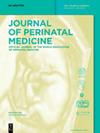胎儿先天性膈疝合并宫内生长受限时产前肺测量的偏差
IF 1.7
4区 医学
Q3 OBSTETRICS & GYNECOLOGY
引用次数: 0
摘要
目标 由于母体或胎盘因素导致胎儿无法充分发育,这种情况被称为宫内生长受限(IUGR)。在这种情况下,胎儿头部的生长通常会受到抑制,从而导致胎儿头部和身体大小不协调。我们的目的是了解 IUGR 是否会影响产前超声波测量,以评估先天性膈疝(CDH)患者的肺部发育情况。方法 对 2007 年至 2016 年所有产前诊断为 CDH 的患者进行回顾性病历审查(IRB#2017-6361)。收集的数据主要包括患者人口统计学特征、胎儿和新生儿人体测量数据以及胎儿肺部参数。在147名CDH患者中,19名(12.9%)患者在妊娠30周前被诊断为IUGR,20名(13.6%)患者在妊娠30周后被诊断为IUGR。结果 与非 IUGR 组相比,IUGR 且观察到的肺头比值(O/E LHR)小于 25% 的患者出院时和出院后的存活率都更高(P=0.226,OR 2.25 95 % CI 0.60-1.08 和 P=0.175,OR 2.40 95 % CI 0.66-1.17)。此外,IUGR 和 O/E LHR 低于 25% 的患者对 ECMO 的需求明显低于无 IUGR 的患者(38.5% 对 80.0%,P=0.005)。结论 本研究证实,在存在 IUGR 的情况下,预测 CDH 患者肺发育不全的宫内测量会产生误导,导致高估。本文章由计算机程序翻译,如有差异,请以英文原文为准。
Bias in the prenatal lung measurements in fetal congenital diaphragmatic hernia with intrauterine growth restriction
Objectives The failure of a fetus to develop to its full potential due to maternal or placental factors is known as intrauterine growth restriction (IUGR). Fetal head growth is usually preserved in that situation producing a potential discordance between head and body size. Our goal is to discover if IUGR has an impact on the prenatal ultrasound measurements taken to assess pulmonary development in congenital diaphragmatic hernia (CDH). Methods A retrospective chart review (IRB#2017-6361) was performed on all prenatally diagnosed CDH patients from 2007 to 2016. Patient demographics, fetal and neonatal anthropometric measurements, and fetal lung parameters were the main subjects of the data that were gathered. Fetal growth was assessed by the curves based on US data by Olsen et al. and by Peleg et al. Of 147 CDH patients, 19 (12.9 %) patients were diagnosed with IUGR before the 30th gestational week while there were 20 (13.6 %) patients after the 30th gestational week. Results Patients with IUGR and the observed-to-expected lung-to-head ratio (O/E LHR) less than 25 % had better survival rates both to discharge and date compared to non IUGR group (p=0.226, OR 2.25 95 % CI 0.60–1.08 and p=0.175, OR 2.40 95 % CI 0.66–1.17, respectively). Moreover, the ECMO need of the patients who had IUGR and O/E LHR less than 25 % was significantly less than the patients without IUGR (38.5 vs. 80.0 %, p=0.005). Conclusions This study confirms that the intrauterine measurements to predict pulmonary hypoplasia in CDH patients are misleading in the presence of IUGR and cause an overestimation.
求助全文
通过发布文献求助,成功后即可免费获取论文全文。
去求助
来源期刊

Journal of Perinatal Medicine
医学-妇产科学
CiteScore
4.40
自引率
8.30%
发文量
183
审稿时长
4-8 weeks
期刊介绍:
The Journal of Perinatal Medicine (JPM) is a truly international forum covering the entire field of perinatal medicine. It is an essential news source for all those obstetricians, neonatologists, perinatologists and allied health professionals who wish to keep abreast of progress in perinatal and related research. Ahead-of-print publishing ensures fastest possible knowledge transfer. The Journal provides statements on themes of topical interest as well as information and different views on controversial topics. It also informs about the academic, organisational and political aims and objectives of the World Association of Perinatal Medicine.
 求助内容:
求助内容: 应助结果提醒方式:
应助结果提醒方式:


